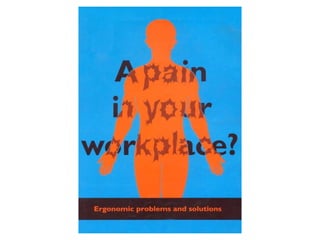Ergo
- 1. ╠²
- 2. Work Physiology Extremely Heavy Work During such work the lactic acid concentration in blood and oxygen deficit achieve such magnitude that frequent rest period are needed, even for trained and capable person
- 3. Ō£ö Type of Solution Type of Solution Workstation Design Task Design Component Design Tool Design Machinery Design Workspace Organisation Mechanisation Automation
- 4. Ō£ö Type of Solution Format for EWG Survey Type of Solution / Photo /Sketch Risk Factor Operation / Photo Affected Part of the Body / Ergoman Details of the Solution
- 5. RISK FACTORS
- 6. ╠²
- 7. ╠²
- 8. ╠²
- 9. ╠²
- 10. ╠²
- 11. ╠²
- 12. ╠²
- 13. ╠²
- 14. ╠²
- 15. PULLING / PUSHING / LIFTING BULKY LOADS SEDENTARY BODY POSTURE AWKWARD BODY POSTURE/EXCESSIVE REACH TWISTING & CARRYING LOADS REPETITIVE BODY POSTURE EXCESSIVE FORCE AT WORK EXTREME TEMPERATURES IMPROPER WORK POSTURE VIBRATION-HAND/ARM or WHOLE BODY. IDENTIFYING RISK FACTORS IN JOBS GRIP / WRIST DEVIATION ! RISK FACTORS
- 16. ORDER OF DESIGN PRIORITY FIRST PRIORITY: Design for Minimum Risk SECOND PRIORITY: Incorporate Safety Devices THIRD PRIORITY: Provide Warning Devices FOURTH PRIORITY: Develop & Implement Operating Procedures and Employee Training Programmes FIFTH PRIORITY: Use PPE
- 17. ORDER OF DESIGN PRIORITY FIRST PRIORITY: Design for Minimum Risk Top priority - eliminate hazards in the design process Risk reduced to an acceptable level through design decisions
- 18. ORDER OF DESIGN PRIORITY SECOND PRIORITY: Incorporate Safety Devices If hazards cannot be eliminated or their risks adequately reduced to acceptable level through design process provide guards, incidental safety devices, etc.
- 19. ORDER OF DESIGN PRIORITY THIRD PRIORITY: Provide Warning Devices Develop systems to detect hazardous conditions & warn personnel of the hazards Warning signals should be designed to help personnel to react promptly & correctly to a hazardous situation Standardization of signals
- 20. ORDER OF DESIGN PRIORITY FOURTH PRIORITY: Develop & Implement Operating Procedures and Employee Training Programmes SOPŌĆÖs Work Instructions On the Job Training Training & Education
- 21. ORDER OF DESIGN PRIORITY FIFTH PRIORITY: Use PPE When all other techniques cannot eliminate or control a hazard, employees should be provided with the appropriate PPE
- 22. ’Ć│ Type of Solution Type of Solution Workstation Design Task Design Component Design Tool Design Machinery Design Workspace Organisation Mechanisation Automation
- 23. ’Ć│ Type of Solution Format for EWG Survey Type of Solution Risk Factor Operation Affected Part of the Body Details of the Solution
- 24. FOR A HEALTHY AND SAFE LIFE Avoid repetitive motions. Reduce exertion. Maintain good posture. Use fixtures to hold products, parts and tools. Change positions; have movements and flexibility. Avoid lifting, twisting, reading/working bent over. Use correct grips, Avoid long reaches. Provide correct work heights.
























